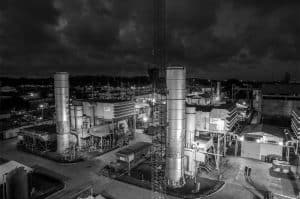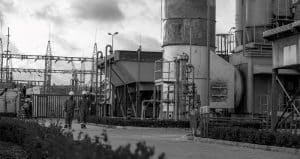Introduction to Songas Thermal Power Station
Songas Thermal Power Station is a critical component of Tanzania’s energy landscape, playing a pivotal role in the country’s ongoing energy transition. As one of the largest power generation facilities in the nation, Songas has been a driving force behind the nation’s efforts to meet its growing energy demands and transition towards a more sustainable energy future.
Located in the heart of Tanzania, Songas Thermal Power Station is a state-of-the-art facility that has been operational since the early 2000s. The station’s strategic positioning and impressive capabilities have made it a vital asset in Tanzania’s quest to provide reliable and affordable electricity to its citizens and businesses.
Importance of Songas in Tanzania’s Energy Sector
Songas Thermal Power Station’s significance in Tanzania’s energy sector cannot be overstated. As the country grapples with the challenges of a rapidly growing population and an expanding economy, the need for a robust and reliable energy infrastructure has become increasingly paramount.
Songas has stepped up to the challenge, serving as a reliable and consistent source of power generation for the nation. With its impressive capacity and advanced technology, the power station has been instrumental in supporting Tanzania’s economic growth and development, providing the energy necessary to power industries, businesses, and households across the country.
History and Background of Songas Thermal Power Station

The Songas Thermal Power Station has a rich history that dates back to the early 2000s. The project was initially conceived as a joint venture between the Tanzanian government and a consortium of international energy companies, with the aim of addressing the country’s pressing energy needs.
After years of planning and construction, the power station was finally commissioned in 2004, marking a significant milestone in Tanzania’s energy sector. Since then, Songas has undergone several expansions and upgrades, further enhancing its capabilities and ensuring that it remains a key player in the country’s energy landscape.
Key Features and Capabilities of Songas
Songas Thermal Power Station boasts an impressive array of features and capabilities that make it a formidable player in Tanzania’s energy sector. The power station is equipped with state-of-the-art technology, including:
- Generating Capacity: Songas has a total installed capacity of 190 megawatts (MW), making it one of the largest power generation facilities in Tanzania.
- Fuel Source: The power station utilizes natural gas as its primary fuel source, which is sourced from the nearby Songo Songo gas fields. This fuel source is both abundant and relatively clean, contributing to Songas’ sustainability efforts.
- Efficiency: Songas’ advanced turbine technology and efficient operations ensure that the power station operates at high levels of efficiency, minimizing energy losses and maximizing power output.
- Reliability: The power station’s robust infrastructure and comprehensive maintenance program ensure that it operates reliably, providing a consistent and stable supply of electricity to the national grid.
- Environmental Considerations: Songas has implemented various measures to minimize its environmental impact, including the use of natural gas as a cleaner fuel source and the implementation of rigorous waste management and emission control systems.
Contributions of Songas to Tanzania’s Energy Transition
Songas Thermal Power Station has played a pivotal role in Tanzania’s ongoing energy transition, contributing to the country’s efforts to diversify its energy mix and reduce its reliance on traditional fossil fuels.
One of the key ways in which Songas has contributed to this transition is through its utilization of natural gas as a fuel source. Natural gas is a cleaner and more efficient energy source compared to traditional fossil fuels, and its use at Songas has helped to reduce the country’s carbon footprint and move towards a more sustainable energy future.
Furthermore, Songas’ impressive generating capacity has enabled the power station to meet a significant portion of Tanzania’s growing energy demands, reducing the need for more polluting and resource-intensive energy sources. This, in turn, has facilitated the country’s efforts to transition towards a more diverse and sustainable energy mix, incorporating renewable technologies such as solar and wind power.
Challenges and Future Prospects of Songas
While Songas Thermal Power Station has been a remarkable success story in Tanzania’s energy sector, the power station is not without its challenges. One of the primary concerns is the long-term availability and affordability of the natural gas fuel source, as the country’s gas reserves may eventually become depleted or subject to price fluctuations.
To address these challenges, Songas and the Tanzanian government are exploring ways to diversify the power station’s fuel sources, including the potential integration of renewable energy technologies such as solar and wind power. This would not only help to ensure the long-term sustainability of the power station but would also contribute to Tanzania’s broader energy transition goals.
Additionally, the government is working to implement policies and regulations that support the development of renewable energy and encourage investment in this sector. This, in turn, could create new opportunities for Songas to expand its operations and become an even more integral part of Tanzania’s energy future.
Environmental Impact and Sustainability Measures of Songas
As a responsible and forward-thinking energy provider, Songas Thermal Power Station has placed a strong emphasis on environmental sustainability and minimizing its ecological footprint. The power station has implemented a range of measures to ensure its operations are as eco-friendly as possible, including:
- Emission Control: Songas has invested in state-of-the-art emission control systems to reduce its carbon footprint and comply with stringent environmental regulations.
- Waste Management: The power station has implemented comprehensive waste management protocols to ensure that all waste products are properly disposed of or recycled, minimizing the impact on the surrounding environment.
- Water Conservation: Songas has implemented water conservation measures, including the use of reclaimed water for cooling and other operational processes, to reduce its water consumption and protect local water resources.
- Biodiversity Protection: The power station has worked closely with local environmental authorities to ensure that its operations do not adversely impact the surrounding biodiversity, including the protection of sensitive ecosystems and wildlife habitats.
- Renewable Energy Integration: As part of its commitment to sustainability, Songas is exploring the integration of renewable energy technologies, such as solar and wind power, to further reduce its environmental impact and contribute to Tanzania’s energy transition.
Comparison with Other Power Generation Technologies in Tanzania
When compared to other power generation technologies in Tanzania, Songas Thermal Power Station stands out as a highly efficient and environmentally-friendly option. While the country does have a growing renewable energy sector, with the development of solar and wind power projects, Songas’ natural gas-fired technology offers several advantages:
- Reliability: Songas’ consistent and stable power generation ensures a reliable supply of electricity, which is crucial for supporting Tanzania’s economic growth and development.
- Efficiency: The power station’s advanced turbine technology and efficient operations result in higher levels of energy conversion, reducing overall energy losses and maximizing power output.
- Environmental Impact: Songas’ use of natural gas as a fuel source, along with its robust emission control and waste management systems, make it a more environmentally-friendly option compared to traditional fossil fuel-based power plants.
- Scalability: The power station’s modular design and ability to expand its generating capacity allow it to adapt to Tanzania’s growing energy demands, making it a flexible and scalable solution.
Government Policies and Support for Songas and Renewable Energy

The Tanzanian government has recognized the crucial role that Songas Thermal Power Station plays in the country’s energy sector and has taken steps to support the power station’s operations and development. This includes the implementation of favorable policies and regulations that encourage investment in the energy sector, as well as the provision of financial and technical support for the power station’s expansion and modernization efforts.
At the same time, the government has also placed a strong emphasis on the development of renewable energy sources, such as solar and wind power. This has led to the creation of various incentives and support mechanisms, including tax credits, feed-in tariffs, and streamlined approval processes, to encourage private sector investment in these technologies.
By striking a balance between the support for Songas and the promotion of renewable energy, the Tanzanian government is working to create a diversified and sustainable energy mix that can meet the country’s growing energy demands while also reducing its environmental impact and contributing to its long-term energy transition goals.
Conclusion: The Role of Songas in Tanzania’s Energy Future
Songas Thermal Power Station has undoubtedly been a catalyst for Tanzania’s energy transition, playing a vital role in the country’s efforts to meet its growing energy needs and transition towards a more sustainable energy future. With its impressive generating capacity, efficient operations, and commitment to environmental sustainability, Songas has become a cornerstone of Tanzania’s energy landscape.
As the country continues to grapple with the challenges of energy security and environmental protection, the role of Songas will only become more crucial. By leveraging its strengths and exploring new opportunities for growth and diversification, the power station can continue to be a driving force behind Tanzania’s energy transition, helping to power the nation’s economic and social development for years to come.
For more articles related to Energy in Tanzania click here!
































